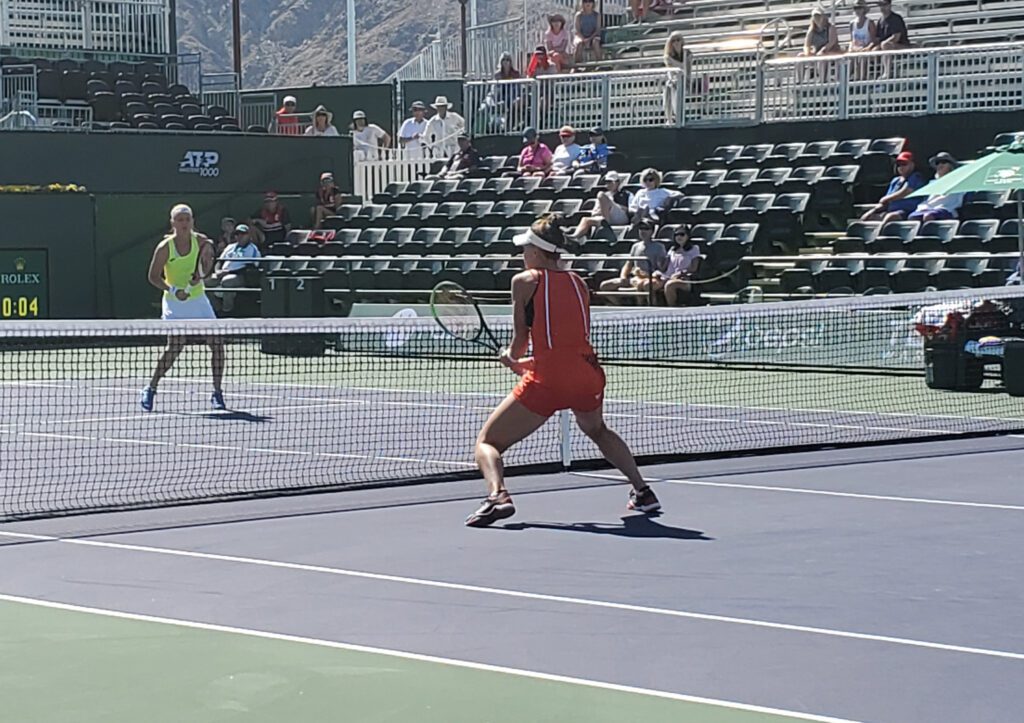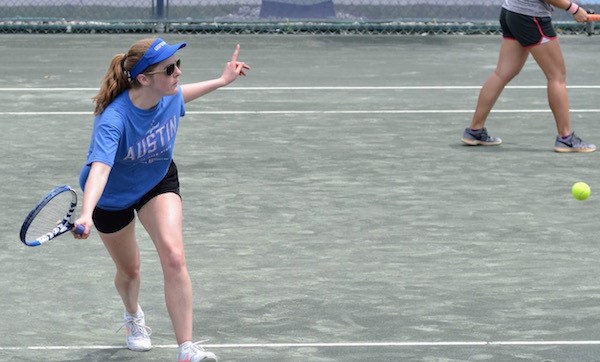Coming to the net is obviously important in doubles, but when I watch USTA matches at the 3.0 to 4.5 level, I see a lot of people who look unsure.
A lot of doubles players will start to move forward then move back. Or maybe they’ll move forward too late and without confidence.
Below are 3 times you should always move to the net in doubles whether you’re standing back serving, returning, or stuck in a rally.
But first, why should you even come to the net?
Want to Improve Your Doubles Game? Come to the Net!
When you watch a lot of USTA matches, the winning team often plays back and out rallies the opponent crosscourt. Can’t we just do that?
The answer is… Yes, but it’s a lot harder.
COURSE
Net Play Strategy for Doubles
Masterclass on skills, strategy, and mindset for dominant net play in doubles!
- Over 190 minutes of Video Doubles Lessons
- 25 Whiteboard Video Lessons
- Video Analysis of over 30 ATP & WTA doubles points

You’ll learn from Will Boucek, an ATP & WTA Doubles Strategy Analyst
The truth is, most doubles points do end at the net, so if you can train yourself to get there at the right time, you’ll immediately become a better tennis player and have a clear advantage over your opponents.
Whether you’re trying to move up to the next NTRP level, or just trying to improve your doubles play, you have 2 options.
Option 1: Out rally your opponent
If you want to do this, call your local courts and book 5 hours of ball machine time per week for the next year. Sit at the baseline and grind it out against the ball machine for hours until your groundstrokes get so good, you’ll move up.
Practice time = over 250 hours! (5 hours/week x 1 year)

Option 2: Go to the net!
If you want to do this, you simply change your positioning and how you move on the court. You don’t need to practice this except in matches. Just test out different times to come into the net, and see what works best for you.
Practice time = 0 hours
So now you know. Get to the net more to become a better doubles player.
Why Coming Forward to the Net in Doubles is the Best Strategy
I’ve explained that moving to the net is an easy way to improve, but why does it help so much?
There are 3 reasons that coming forward works in tennis.
1. It Takes Away Time From Your Opponent
I’m going to make up some numbers here but you’ll get the point…
If you hit a ball from behind the baseline, it will take, let’s say 2 seconds, to hit the back fence on the other side if you hit a winner.
When you hit the ball from inside the service line, it will take 1.2 seconds to go through the opponent’s court and hit the fence. That is 40% less time for your opponent to get to the ball than they had before.
Pro Tip: This is true in singles too. You’ve probably seen that graphic on TV about baseline position. The player who moves forward more is taking away time from their opponent.
2. It Puts Pressure On Your Opponent
Imagine you’re at the baseline about to hit a forehand, and you have one of two scenarios to choose from.
- Your opponent is behind the other baseline.
- Your opponent is at the net.
Which position would you rather your opponent be in?
Time and time again, I see people swing a little harder, go for a more difficult shot, and make errors in scenario 2.
Going to the net puts pressure on your opponent to come up with an awesome shot. Most of the time, they’ll miss 😉
3. You Have an Easier Shot at the Net
As you move forward for a volley, you are creating better angles for yourself and lowering your chance of missing in the net (especially if you take the ball high).
Hitting a good volley is generally a higher percentage shot than hitting a groundstroke.
Even if you’re more comfortable from the baseline, from the net have more margin for error. Really you just need to hit the ball in the court to the opponent’s backhand, and you’re likely to win the point. From the baseline, you have to hit with more pace, depth, and even better direction.
MOST POPULAR COURSE!
25 Winning Doubles Tactics
Guaranteed to help you play smarter & win more matches.
- Over 50 video doubles lessons
- 60+ ATP & WTA points analyzed
- Nearly 3 hours of strategy content

Will Boucek – ATP & WTA Doubles Strategy Analyst.
3 Times You Should Start Moving To The Net
There are the obvious times to move to the net, like on an approach shot, but I want to show you 3 times I like to move in that you may not be using.
1. Anytime the Opponent Looks Uncomfortable
This is the single best way to force an error. If your opponent:
- Is hitting from way behind the baseline.
- Is on their heels.
- Has a weak backhand, and you can find it.
- Is running for a ball and off-balance.
Come to the net!
They’ll see you come in, swing harder, and miss most of the time.

2. When the Opponent Doesn’t Hit with Pace
The hardest part of getting to the net is the half volley. If you’re playing against someone who doesn’t hit the ball very hard, then you have plenty of time to get to the net.
If you want even more time to get in, take some pace off of your shot. But make sure it has depth!
High, deep, topspin to the backhand is usually a safe bet. However some players can lob well off of this shot, so you can try a slow slice with depth too.
3. When Your Partner Hits a (good) Volley
As soon as I see the opponent hit at my doubles partner at the net, I’ll start to move in (just a step or 2).
But I’ll wait to see if it’s a good volley. If not, it’s okay to retreat back to your position. But when I see it’s a good volley, I’ll start to sprint in.
Why?
If my partner hit a good volley, then the opponent is in an uncomfortable position and likely to hit a short ball or float one back. At this point, it’s best to be on top of the net to end the point.
Bonus Tip #4. When the opponents are at the net and…
You give them a shoeshine on their backhand volley.
When you hit it low to their backhand volley, they’ll pop the ball up more often than not. That’s why you should be aiming here when the opponents are at the net. It’s often a better play than a lob, and it’s a great time to poach.
Don’t forget step two though.
Once you know you hit that forehand hard and low at their feet, come forward behind it.
Come to the Net As Much As You Can
When you’re thinking about your doubles strategy on, or off the court, you should be thinking of as many ways as possible to get to the net.
A good question is…
Which shot on that last point could I have come forward on?
The theme here is that you should always be looking for more opportunities to come forward to the net when you see your opponent is uncomfortable.
It puts pressure on them and makes them hit a difficult passing shot, while also putting yourself in a better position to hit a winner or force an error.
Train your “move into the net muscle” more and more. Over time, you’ll level up your doubles game.
What is your favorite time to come forward to the net in doubles that most people don’t expect?? Comment below!


When hitting a high and deep lob.
Great one Christine!
This might also fall into the category of when the opponent looks uncomfortable. Any deep balls are great times to move forward 🙂
At least in 6.5 combo doubles, I’d say the average player has a better likelihood of returning a lob from the baseline than successfully executing an overhead near the service line. And in my brief experience playing doubles, most rallies are crosscourt moonballs until someone makes an error. “Just come to the net!” sounds easy enough, but really that means “get proficient enough with overheads that they are a higher-percentage shot than baseline lobs”. Which still means lots of practice, especially for a singles player just picking up doubles. You can win a lot of 3.0-3.5 singles matches without ever hitting a smash, so overhead is often the weakest stroke for many singles players. It takes MANY reps to get the confidence to embrace the opportunity to hit overheads. Volleys are the least of my worries, since 6.5 combo doubles (at least in my area) seems to attract all the players that can launch a decent lob from anywhere on the court, even if that’s all they can do.
Hey Matt, good points. Practicing volleys and overheads definitely makes coming to the net easier. However to get to the 4.0+ level, players do need to improve those shots. If they want to stay 3.0 or 3.5, then they can get away with staying back more often.
I’d also say that improving your net game is easier than improving your groundstrokes. Volleys especially are very short, technically simple strokes. The overhead is slightly more complex.
If you keep getting lobbed then the first step is to figure out why. I made a video on it 🙂
https://youtu.be/1ZW1sk8Cpjw